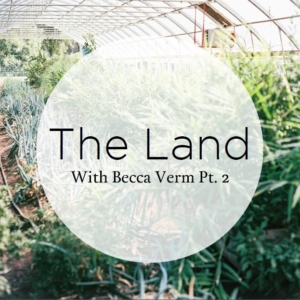 You begin with dirt. Dry, cracked, neglected dirt. Or perhaps some overgrown jungle of a forgotten lot teeming with bounties of invasive grasses and weeds. Slowly peeling back layer after layer, you unearth a weary soil. But you take that limp and lifeless dirt and get to work converting inch after inch, square foot by square foot, into rich, loamy soil ready for planting. In life, there are no short cuts and farming is certainly no exception. This conversion process can take months, if not years to achieve the desired results. The land must be worked, compost must be turned, mulch applied and reapplied, and sometimes seasons of cover crops are needed just to begin the process of farming. But sustainable farming requires this and every farmer involved in such a process understands the end game- that building a long term future in this means nourishing and securing the foundation of it all- the soil. The greatest asset any farmer has is the stewardship they put into their land. Therefore, land access becomes a central pillar to creating a sustainable farm.
You begin with dirt. Dry, cracked, neglected dirt. Or perhaps some overgrown jungle of a forgotten lot teeming with bounties of invasive grasses and weeds. Slowly peeling back layer after layer, you unearth a weary soil. But you take that limp and lifeless dirt and get to work converting inch after inch, square foot by square foot, into rich, loamy soil ready for planting. In life, there are no short cuts and farming is certainly no exception. This conversion process can take months, if not years to achieve the desired results. The land must be worked, compost must be turned, mulch applied and reapplied, and sometimes seasons of cover crops are needed just to begin the process of farming. But sustainable farming requires this and every farmer involved in such a process understands the end game- that building a long term future in this means nourishing and securing the foundation of it all- the soil. The greatest asset any farmer has is the stewardship they put into their land. Therefore, land access becomes a central pillar to creating a sustainable farm.
Land access, however, is the single most daunting challenge for new young farmers to overcome. The reality of our current agricultural landscape is that nearly 40% of America’s 911 million acres of farmland is rented and overall young farmers are more likely to rent land than own it due to financial barriers. Additionally, many of these young farmers aren’t coming from agricultural backgrounds, therefore, they aren’t in a position to inherit land. According to a 2011 survey by the National Young Farmer’s Coalition (to be clear, there aren’t many surveys of this sort)…
“Farm real estate is more expensive than ever- the average prices have more than doubled since 2004. In many cases, this makes it impossible for farmers to pay for their land using agricultural profits alone.
Farm prices are being driven up beyond what a farmer can afford or reasonably pay off on a farm income due to competition from developers and estate, or second home, purchases.
Young farmers are entering agriculture with significant debt from student loans and other sources, reducing their ability to access the neccesary credit and capital to buy land.
Land around urban areas can be more than double the cost of rural land- yet this is where farmers need to be located for their businesses to be successful if they are participating in a direct market model.
Two-thirds of all farmland (573 million acres or 63%) will need a new farmer over the next two and a half decades as older farmers retire.
10% of all farmland in the contiguous US and 25% of rented lands is expected to transfer ownership in the next 5 years.”
The reality of our current food system is that our ability to produce food, support all economies, and protect ecosystems depends on our ability to educate new farmers and empower them to take over management of farmland in a moral and effective manner. If they are struggling to make ends meet every rent check, every utility bill, or if they continuosly struggle to retain aqcuired farmland, they will eventually burn out and find a different occupation. Therefore, this MUST become a sustainable occupation.
Fortunately, there are agencies dedicated to overcoming this specific obstacle. Organizations across the nation like the American Land Trust and the National Young Farmer’s Coalition work tirelessly to help deconstruct barriers to land access by providing resource access, advocating policy changes at the federal level, and empowering young farmers to challenge their own local and state officials through grassroot actions. At our local level, there are farms like Finca Tres Robles, Plant it Forward, and Last Organic Outpost who work with community organizations and city officials to bring to light and combat the significant challenge local farms battle every day.
Ultimately, however, individuals make the difference. By supporting your local farmer’s market, CSA, or locally-sourced restaurants, you give back to the individuals within your community who rely on you most. If you don’t already, consider giving back today.
Here’s a list of local farmer’s markets and CSA farm share programs:
CSA Farm Share Programs by:
Sown & Grown Farms, Tuesdays 4-7 PM
Finca Tres Robles, Wednesdays 2-8 PM
Plant it Forward Farms
TUESDAYS:
Rice University 3:30- 6:30 PM (5600 Greenbriar)
Spring Branch 2-6 PM (1504 Wirt)
WEDNESDAYS
City Hall 11- 1:30 PM (500 McKinney)
THURSDAYS
Kingwood 3-7 PM (8 North Main, Town Center)
FRIDAYS
Feast of Artisans 4-9 PM every other week (1207 FM 3083 in Conroe)
SATURDAYS
Urban Harvest 8-Noon (3000 Richmond at Eastside)
The Farm Stand at Petrol Station 9- 1PM (985 Wakefield)
Pearland Old Townsite 8-Noon (2243 Grand in Pearland)
Grogan’s Mill Village 8-Noon (7 Switchbud Place in the Woodlands)
Farmers Market on Grand Parkway 8-Noon (1225 W Grand Parkway in Katy)
Farmers Market at Imperial 9-1PM (198 Kempner in Sugar Land)
Clear Lake Shores 9-1PM (1020 Marina Bay Drive in Clear Lake)
Tomball 9-1PM (FM 2920 and Cheery St)
SUNDAYS
East End Street Market 10-2PM (Esplinade at Navigation Blvd)
Bridgeland 12:30- 3:30 PM every second Sunday (16902 Bridgeland Landing)
